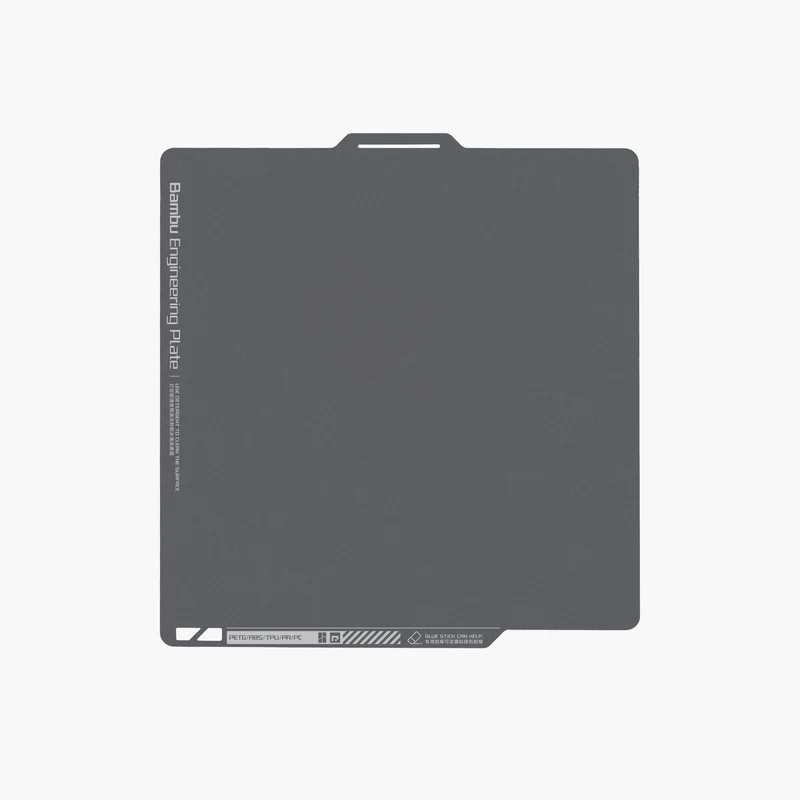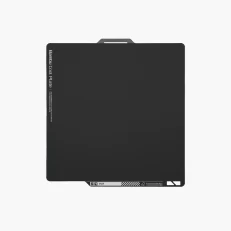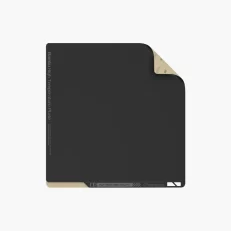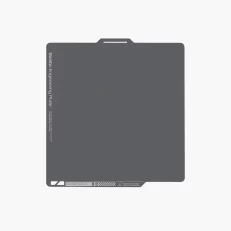Description
Things to know before use
- Variations in the color and luster of the Engineering Plate appearance and the removal of the exposed metal areas are just minor adjustments to optimize the production process and surface quality. If the coating remains on the nozzle when the nozzle is wiped, it will be heated and melted before printing the model. Such changes do not affect leveling, Lidar, adhesion, or range of use. You can purchase with confidence!
- Before auto-leveling, it is necessary to repeatedly rub the nozzle in the special wiping area of the build plate to completely remove any residual material at the tip of the nozzle. The coating in the special-designed wiping area will gradually become worn over time. This is normal and does not affect print quality or nozzle lifetime, so there is no need to worry about any quality issues.
- Bambu Lab recommends only using Bambu Lab official glue on the Cool Plate, and can not be held responsible for any damage caused to plates as a result of using third-party glue on build plates.


Overview
- The Bambu High-Temperature Plate is a sticker that is applied to the Bambu Engineering Plate which can be used on both sides. This is a consumable printing surface that is used in conjunction with a thin coat of glue stick and works well with most common filaments and scenarios.
- The Bambu High-Temperature Plate leaves a smooth finish to the model that comes in contact with the High-Temperature Plate, and might require a bit of post-processing for cleaning up the glue stick.
Recommended Settings for Bambu High-Temperature Plate
Please note that other slicer settings might need to be adjusted based on the printed model and the filament requirements
| Hotbed Temperature | Glue Stick Required? | Upper Glass Cover Plate Removed? | |
| PLA/PLA-CF/PLA-GF | 45~60℃ | Recommended | Yes |
| ABS | 90~100℃ | Recommended | No |
| PETG | 80℃ | Yes | Yes |
| TPU | 35℃ | Recommended | Yes |
| ASA | 90~100℃ | Recommended | No |
| PVA | 45~60℃ | Recommended | Yes |
| PC/PC-CF | 100~110℃ | Yes | No |
| PA/PA-CF/PAHT-CF | 100~110℃ | Yes | No |
Benefits
- Works best with most 3D printing filaments
- Works well with the Automatic Calibration for Flow rate and does not interfere with the LIDAR
- Smooth texture on the surface of the print
- Excellent adhesion and easy print removal
- Can be replaced by the user
Downsides
- It cannot be used without heating the printing surface
- Can be more fragile compared to the Engineering Plate or Textured PEI Plate
- The upper glass cover plate, or the front glass door need to be opened for filaments with a low glass transition temperature
Recommended Settings for Bambu Engineering Plate
Please note that other slicer settings might need to be adjusted based on the printed model and the filament requirements
| Hotbed Temperature | Glue Stick Required? | Upper Glass Cover Plate Removed? | |
| TPU | 30~35℃ | Recommended | No |
| PETG | 70~80℃ | Recommended | Yes |
| ABS | 100~110℃ | Yes | No |
| PC/PC-CF | 100~110℃ | Yes | No |
| PA/PA-CF/PATH-CF | 100~110℃ | Yes | No |
Installation Steps

Step 1: Align the plate with the fixed points of the platform with the name of the plate facing you

Step 2: Lower the plate and secure to the magnetic platform
Product Specification
| Surface temperature resistance | Up to 200℃ | Usable print size | 256*256 mm |
| Flexible spring steel thickness | 0.5 mm | Cool Plate sticker thickness | 0.3 mm |
| Package Weight | 320 g | Package size | 290*290*4 mm |



 or 4 payments of
or 4 payments of 




